The Middle East: Landing Strip for U.S. Military Budgets
Extensive U.S. military aid to Israel, reaching over 17.9 billion dollars since October 2023, far exceeds Iran’s estimated 7.9 billion dollar military budget in 2024. In fact, this aid amount alone, from October 2023 onward, is more than double Iran’s entire military budget.
Additionally, the cumulative costs of wars the U.S. has waged in the Middle East since 2001 exceed 8 trillion dollars—500 times Iran’s regional costs. This figure, according to Donald Trump, the 45th U.S. President from 2017 to 2021, was claimed to be 16 billion dollars.
This stark difference not only reflects U.S. strategic priorities but also mirrors the influence of ideological and political forces within the United States, particularly the long-standing commitment to Zionist aspirations and the role of neoconservative politicians aligned with Zionist lobbies. These astonishing figures, despite the U.S. grappling with domestic financial and economic issues, demonstrate America’s commitment to Israel’s security and maintaining its regional dominance.
Nazmino, while examining the amount of U.S. military aid to Israel compared to the Islamic Republic of Iran’s military budget, proves that this aid is primarily based on a deep commitment to Zionist aspirations and the influence of neoconservative policymakers and pro-Israel lobby groups. This article conducts a comprehensive examination based on evidence and documents regarding these claims, using diverse and credible sources, including academic reports, government documents, international think tank reports, and reputable publications. This analysis, by comparing U.S. military aid to Israel, Iran’s military budget, and U.S. war costs in the Middle East, clarifies the roots, scale, consequences, and implications of these costs.
Scale and Dimensions of U.S. Military Aid to Israel
Since Israel’s establishment in 1948, the United States has provided about 318 billion dollars (inflation-adjusted) in aid, mostly military in recent decades. The 2016 security memorandum commits the U.S. to providing another 38 billion dollars over a ten-year period (2019 to 2028), averaging 3.8 billion dollars annually. This aid is mainly in the form of Foreign Military Financing (FMF) for purchasing advanced U.S. weapons like F-35 fighters and missile defense systems such as Iron Dome.
After October 7, 2023, U.S. aid dramatically increased; by September 2024, 17.9 billion dollars were allocated, and in March 2025, the Trump administration approved another 4 billion dollars in urgent aid to the Zionist regime. Of this total, 5.2 billion dollars were for missile defense systems and 3.5 billion for war purchases, significantly exceeding previous averages and showing Washington’s doubled commitment to Israel’s security and maximizing its regional dominance.
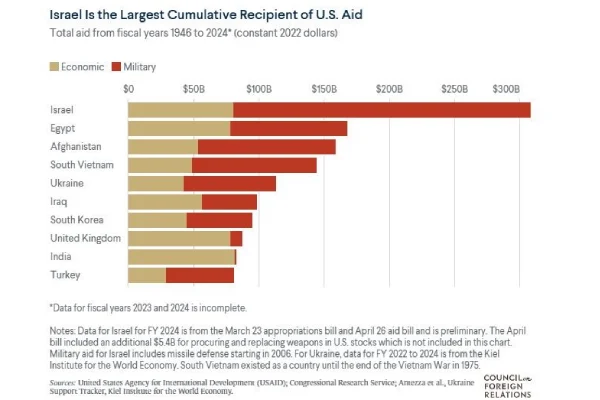
Staggering Military Aid to Israel
Overall, since 1948, the United States has provided over 260 billion dollars in military and economic aid to Israel, with recent focus more on military aid. As mentioned, in the fiscal year after October 7, 2023, U.S. military aid to Israel reached 17.9 billion dollars, exceeding the annual 3.8 billion dollar commitment under the 2016 memorandum (Obama era).
This special aid package includes 3.3 billion dollars in FMF, 500 million dollars for missile defense systems like Iron Dome and Arrow, and a supplemental 14.1 billion dollar package for ammunition, including artillery shells and precision-guided bombs. This package also includes deploying the THAAD missile defense system amid escalating conflicts with Hamas, Hezbollah, and Iran. This significant increase demonstrates the United States’ commitment to maintaining Israel’s qualitative military edge and ensuring its technological superiority over regional adversaries.
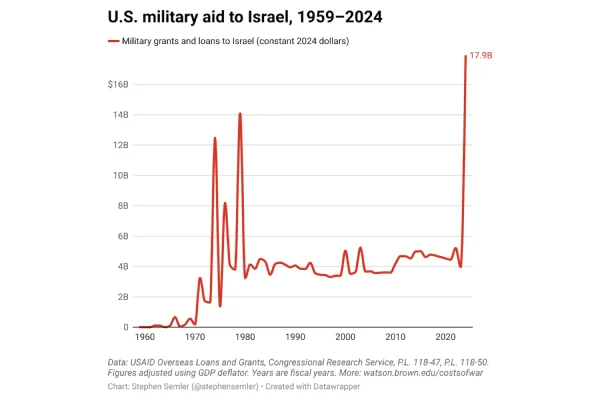
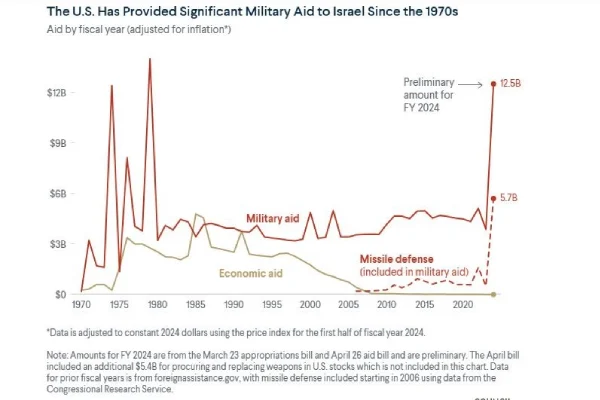
Details of U.S. Military Aid to Israel Since October 2023
Category | Amount (Dollars) | Aid Details |
Foreign Military Financing FMF | 3.3 billion | Annual weapons aid |
Missile Defense | 500 million | Funding for Iron Dome, Arrow, and David’s Sling systems [1] |
Supplemental Aid (2024) | 14.1 billion | Ammunition supply, including 2,000-pound bunker-buster bombs and precision-guided bombs |
Urgent Aid | 4 billion | Immediate support for Israel’s defense needs |
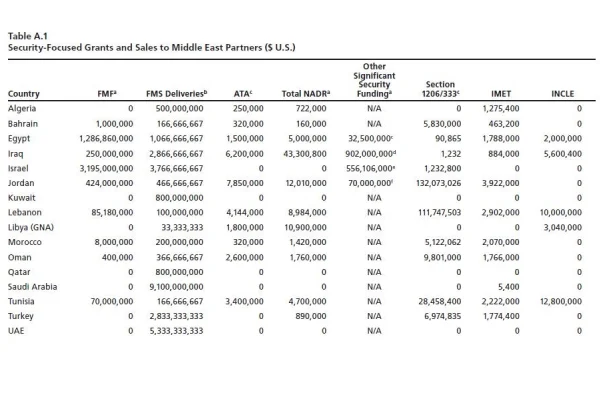
Iran’s Military Budget Compared to Israel
In contrast, Iran’s military expenditures are far lower. According to the Stockholm International Peace Research Institute (SIPRI), the most credible source for estimating global military spending, Iran’s defense costs in 2024 were about 7.9 billion dollars, a 10% decrease from 2023.
Notably, compared to just one 21.9 billion dollar U.S. aid package to Israel since October 2023, Iran’s annual military budget that year is even less than half that amount. This comparison fully confirms the claim that U.S. aid to the Zionist regime in one year exceeds double Iran’s defense budget figure.
Based on other reports, Iran’s military budget for 1403 (March 2022 to March 2023) is estimated at about 7.16 billion dollars based on an exchange rate of 43,149 toman per dollar. The International Institute for Strategic Studies (IISS) also reported Iran’s 2023 military budget as 7.41 billion dollars. Overall, various reports show a glaring disparity between U.S. aid and Iran’s total military budget figure.
Year | Budget (Dollars) | Exchange Rate (Toman/Dollar) | Source |
2022 | 6.85 billion | – | World Bank |
2024 | 7.9–7.41 billion | Variable | IISS, SIPRI |
Trillion-Dollar Commitment to Zionism
According to estimates from Brown University’s “Costs of War” project, U.S. military aggressions in the Middle East since 2001, including attacks on Iraq, Afghanistan, and Syria, have cost over 8 trillion dollars. This amount includes 2 trillion dollars in direct war costs, 2 trillion for veteran care, and 4 trillion in loan interest. Since October 7, 2023, the U.S. has also spent another 4.86 billion dollars on regional offensive military actions, including naval attacks on Yemen, involving costly aircraft carrier deployments, missiles, etc. This 8 trillion dollar figure, compared to Trump’s estimated 16 billion dollars for Iran’s total regional costs, shows a staggering 500-fold disparity.
Category | Cost (Dollars) | U.S. Military Aggressions |
Post-9/11 Wars (2001–2024) | 8 trillion | Including Iraq, Afghanistan, Syria, etc. |
Regional Aggressions (2023–2024) | 4.86 billion | Naval attacks, force deployments (peak 50,000 in August 2024) |
War Debt Interest | 4 trillion | Projected until 2050 |
Strategic Consequences of Massive U.S. Aid to Israel
- Disrupting Stability in the Middle East
The 17.9 billion dollar U.S. aid to Israel and 8 trillion dollar war costs indicate a broader strategy to counter Iran’s influence and disrupt regional stability. Israel’s conflicts with Iran-backed groups and direct confrontations, like Iran’s missile attacks in April and October 2024, provided pretexts to strengthen U.S. support, including unprecedented deployments of American forces (50,000 in August 2024) and THAAD systems. However, from some Western experts’ perspectives, the high U.S. costs have still failed to curb Iran’s influence, raising questions about the effectiveness of these massive expenditures.
- Economic and Political Considerations
The 8 trillion dollar U.S. war costs have also increased federal debt, with interest projected to reach 1.7 trillion dollars by 2030. The 17.9 billion dollar aid to Israel in 2024 has intensified internal debates and protests, with critics like Josh Paul pointing to the formation of war crimes in Gaza by the Zionist regime with U.S. help—a case that, despite economic harm to the U.S., has doubly negatively impacted public opinion toward their government. He even resigned from U.S. government membership in 2025 due to these crimes.
- Disregard for Human and Ethical Dimensions
The scale of U.S. military aid to Israel, especially in sending offensive weapons, has been criticized by many international experts and activists due to the extremely high civilian casualties in Gaza (over 43,000 killed by October 2024). Critics argue that unrestricted aid facilitates violations of international humanitarian law, leaving no constraints.
American Evangelicals Supporting Zionism
Joe Biden’s October 2023 statements calling himself a “Zionist” reflect the ideological alignment and commitment of American politicians to Zionism beyond mere political connections—a view accepted by many American politicians who see preserving Israel as an ethical necessity and strategic issue. This view also exists among Evangelical Christians forming part of American politicians; according to a 2022 Pew Research Center survey, 55% of U.S. Evangelicals consider supporting Israel a religious duty, strengthening bipartisan support for excessive military aid to this regime.
Interestingly, 27% of white American Evangelicals in 2022 believed there should only be one country of Israel with a Jewish population and did not recognize a country called Palestine and its people. Also, 30% of white American Evangelicals in 2022 believed God granted the land of Israel (occupied Jerusalem) to the Jews as their right.
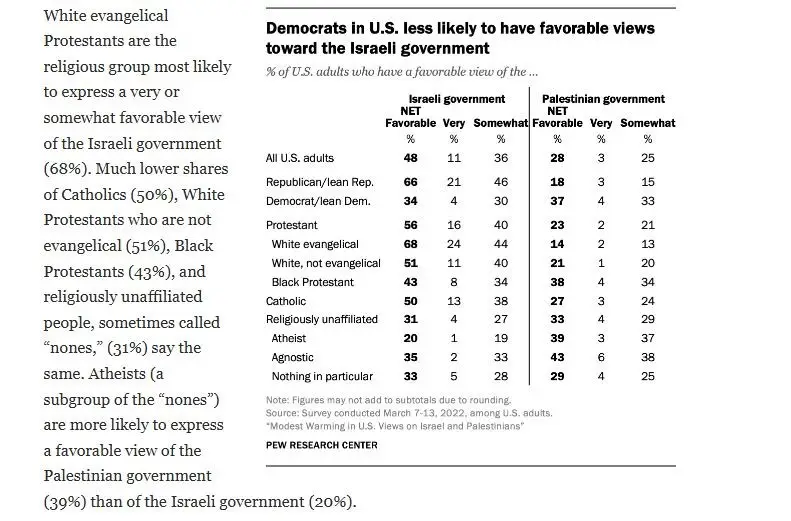
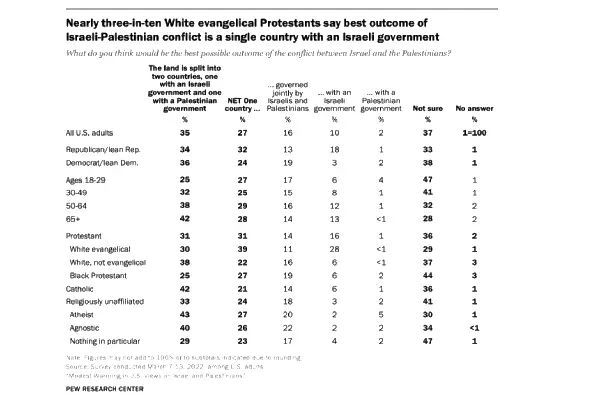
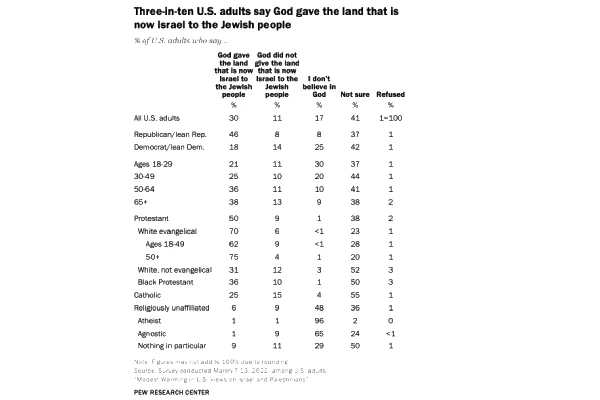
Role of Neocons and Zionist Lobbies
Neoconservative politicians, known for hawkish foreign policy views and strong support for Israel, have played a central role in continuing U.S. military aid. Neocons in George W. Bush’s administration supported policies aligning U.S. interests with Israel, including the 2003 Iraq war—a war that, according to researchers like John Mearsheimer and Stephen Walt, was clearly influenced by pro-Israel lobbies.
The American Israel Public Affairs Committee (AIPAC) also plays a key role; according to OpenSecrets, pro-Israel groups donated 30.9 million dollars to U.S. election campaigns in 2020. AIPAC’s influence ensures U.S. aid to Israel remains a priority, often used as a tool against Iran. Notably, during Netanyahu’s White House meeting with Trump in 2025, Iran was introduced as a common threat to both countries.
Strategic and Ideological Synergy
The ideological alignment of neocons and Zionist lobbies is fully evident in the U.S. commitment to preserving Israel’s “Qualitative Military Edge” (QME)—a principle recognized in the 2008 Naval Vessel Transfer Act. This policy ensures Israel maintains military superiority over all regional actors like Iran; in this framework, U.S. aid to Israel plays a compensatory role against arms sales to Arab countries (and in fact, U.S. arms sales to regional countries must qualitatively be lower than the Zionist regime’s military capabilities and capacities).
Neocons like Senator Jesse Helms called Israel “America’s aircraft carrier in the Middle East” and defended it as a strategic necessity. However, critics like General David Petraeus have warned that one-sided U.S. bias toward Israel increases hatred of America in the Arab world and complicates relations with regional allies. Even with such concerns, the influence of groups like AIPAC and the powerful dominance of Evangelicals ensure U.S. aid continues unconditionally, rendering any reduction efforts fruitless.
The charts below fully illustrate the maintenance of the Zionist regime’s military superiority over other U.S. arms-buying governments in the region from 2000 to 2024. According to this principle, based on a congressional law first passed in 1992, the U.S. government must carefully consider the volume and quality of arms sales to keep them more and better than what is provided to Israel, always placing the regime in a superior position relative to its regional neighbors.

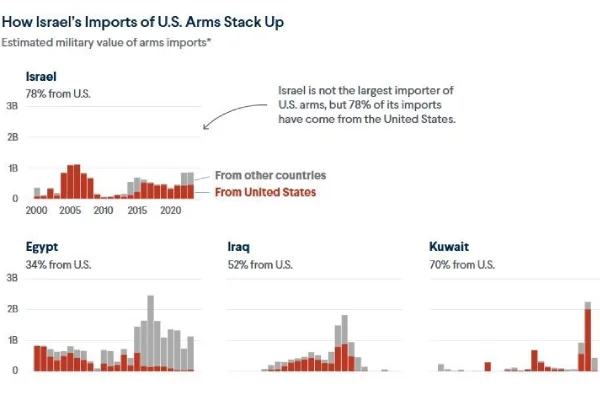
Internal Criticisms in American Society
Massive U.S. aid to Israel, influenced by Zionist aspirations and neocon pressures, has significant consequences. Domestically in America, these resources are diverted from urgent needs like people’s infrastructure to occupied territories; as users on social network X criticize: “Why should Israel prioritize over our infrastructure?”
Regionally, this aid strengthens Israel’s military power but simultaneously escalates tensions with Iran and resistance axis groups; as Houthi attacks in 2024 cost the U.S. an equivalent of 4.86 billion dollars. Critics argue AIPAC and neocon influence has distorted U.S. foreign policy; a 2024 Foreign Policy article notes that unconditional aid has been an obstacle to addressing the humanitarian crisis in Gaza. Balancing commitment to Israel with diplomatic paths, like reviving the Iran nuclear deal, still faces lobby pressures.
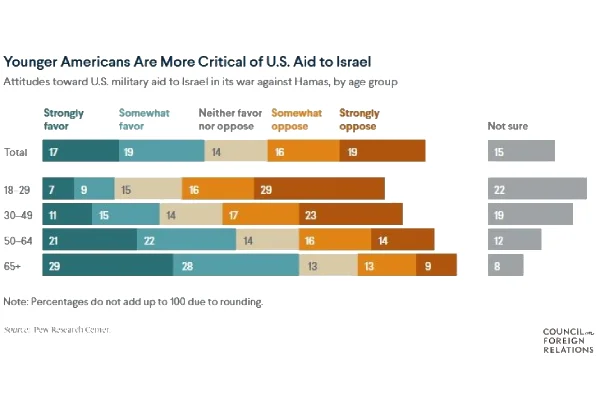
The 21.9 billion dollar U.S. aid to Israel since October 2023 versus Iran’s 7.9 billion dollar budget in 2024 shows a deep gap stemming from the United States’ commitment to Zionism and the influence of neocon politicians and Zionist lobbies. AIPAC’s financial influence, Evangelical support, and neocon ideological backing have kept Israel’s security at the top of U.S. foreign policy priorities. Even if this comes at the cost of regional instability and neglect of domestic U.S. needs. Although this aid guarantees Israel’s military superiority, it simultaneously intensifies conflicts and increases ethical and strategic costs for the United States.
Institutionalizing Unconditional Support for Israel
After the Iraq attack, neoconservatives, despite some retreats and criticisms, succeeded in turning many of their views into dominant U.S. foreign policy discourse. Annual multi-billion dollar military support for Israel, security guarantees, confronting Iran’s nuclear program, opposing Palestinian refugee return, and supporting settlement expansion became fixed principles in U.S. policy.
During this period, neoconservative influence extended beyond government to think tanks, media, universities, and even religious institutions and Evangelical churches. As a result, a stable coalition formed between Jewish neoconservatives and Evangelical right-wingers, justifying support for Israel on strategic, religious, and apocalyptic grounds. This policy was not fully abandoned even during the Obama administration, although Obama made efforts to negotiate with Iran and halt settlements.
Neoconservatives’ Role in Confronting the Resistance Axis and Shaping Regional Fronts
However, neoconservatives and their congressional allies, including figures like Tom Cotton and Marco Rubio, exerted significant pressure to continue aggressive policies against the resistance axis. During Donald Trump’s presidency, neoconservatives returned strongly with figures like John Bolton, Nikki Haley, and Jared Kushner. Moving the U.S. embassy to Jerusalem, recognizing Israeli sovereignty over the Golan, and the so-called “Deal of the Century” were among their achievements. Neoconservatives, by supporting Saudi Arabia, the UAE, and compromising regimes, sought to form a broad front to confront the resistance axis, with Israel at its heart.
Neoconservatives have operated not just as an intellectual current but as a structuring force in U.S. foreign policy. They succeeded in transforming Israel from a regional ally to the strategic axis of U.S. policy in West Asia. Unconditional support for Israel is not merely due to lobbying or cultural influence but part of a larger “liberal imperialism” project and maintaining U.S. hegemony worldwide. Neoconservatives see Israel as the vanguard of this order—an order based on interventionism, political engineering, and legitimizing U.S. dominance in crisis regions.
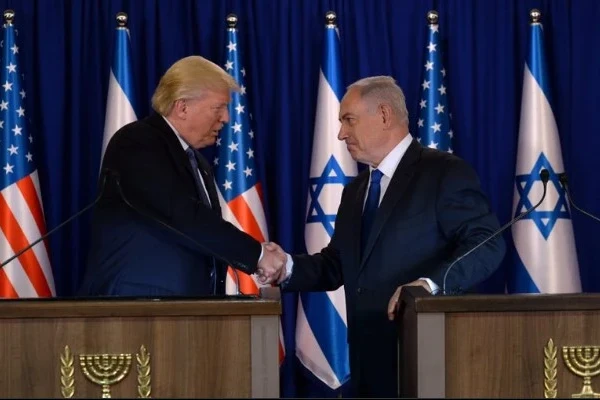

Commitment to Zionism in U.S. Foreign Policy Structure
Efforts to explain the reason for massive U.S. aid to Israel are often through focusing on a specific political party, ideological faction, or powerful individual. But data on U.S. support for Israel shows this is not merely a partisan issue, nor ideological, nor even individual. Instead, it is a structural issue institutionalized in U.S. foreign policy. Aid to Israel is not solely linked to neoconservatives, Republicans, or someone like Senator Lindsey Graham but extends across a broad level of the U.S. political class.
For example, votes on military aid to Israel show support is typically bipartisan. In 2021, the U.S. House of Representatives voted overwhelmingly 420-9 to allocate a one billion dollar emergency aid for the Iron Dome missile defense system. Of the 9 opposing votes, only 8 were Democrats and one Republican, with the vast majority in favor.
Democrats and Republicans: Bipartisan Alignment in Supporting Israel
Moreover, presidents from both parties have always supported aid to Israel. During George W. Bush’s presidency, security aid to Israel reached unprecedented levels, but the Obama administration not only continued this trend but approved the largest U.S. military aid package to Israel in history in 2016. This package, known as the Memorandum of Understanding (MOU), solidified the U.S. commitment to pay 38 billion dollars to Israel over ten years (2019–2028).
In fact, both Democrats and Republicans in Congress have always supported such agreements, with approvals usually by absolute majority. For instance, in approving the 38 billion dollar MOU in 2016, key members from both parties, including Nancy Pelosi (Democrat) and John McCain (Republican), played central roles.
Overall, U.S. aid to Israel is not merely the result of one party or faction’s decision but the product of an institutionalized structure in American foreign policy—a structure based on specific strategic assumptions about U.S. interests in the Middle East and Israel’s role as a security partner that must be protected.
How does money influence U.S. policies and regulations?






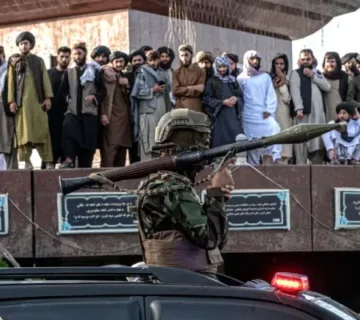

no comment